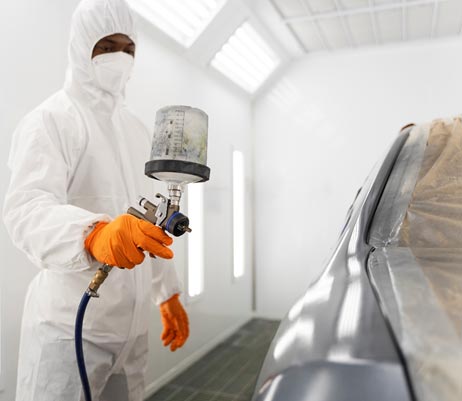PU-Paints

Berger Polyurethane Varnish is a taint-free paint. It dries to form a hard and tough film and provides water and moisture resistance. It has a good flow and levelling properties and is resistant to mild chemicals spillage and resistant to hot water spillage.
The Many Uses of Polyurethane Paint and Coatings
Polyurethane paint, also referred to as PU paint or PU coating, is a durable, highly-resistant coating used in industrial and architectural coating systems. It is popular in the marine industry and is used for numerous applications including coatings, rigid and flexible foams, and varnishes. It is also used in steelwork, concrete, wood, and other substrates.
Polyurethane is a reaction polymer, a combination of a polyol resin and an isocyanate hardener or curing agent. Essentially, a polyurethane coating is a liquid plastic which dries to form a paint-like film on an underlying substance or layer. Polyurethane paint provides durability, resistance to chemicals, water, abrasion, and temperature, as well as an attractive glossy finish. The most common application of polyurethane is as a solid foam, accounting for approximately 60% of all polyurethane produced.
What is polyurethane used for?
Polyurethane is a versatile material that can be used for a wide variety of applications. It is commonly used in the manufacture of plastics, insulation, and coatings. Polyurethane is also used in the production of adhesives, sealants, and elastomers. In addition, polyurethane is often used as a food additive and as a component in medical devices. Polyurethane is an ideal material for many applications due to its durability, flexibility, and resistance to chemicals and abrasion.


Marine Polyurethane Clear Coat
Polyurethane can be used to protect a boats paint and to keep the finish on wooden marine vessels visually appealing and more durable. You can apply polyurethane over any type of paint if it is clean and prepared properly. Polyurethane coatings can be applied to exposed wooden surfaces to create a glossy finish that serves to repel water, resist corrosion, and protect from scratches, stains, and UV damage.
5 Key Benefits of Using a Strong Polyurethane Finish
1. Protection
Polyurethane finishes combined with epoxy primers essentially create a smooth protective barrier on any surface they are applied to. This barrier is virtually impenetrable to atmospheric elements such as moisture, salts, and ultra-violet light, so it keeps weathering elements away from the material it is coating.
Polyurethane finishes, when combined with an epoxy primer, provide protection against corrosion. In a coastal environment, it is especially useful for keeping salt and sand from doing damage to buildings and other structures.
Polyurethane finishes also protect against chemicals that can harm concrete and steel, as well. Plus, it keeps harmful bacteria, bird droppings, dirt, and debris from eating away at the building material.
These benefits are why a polyurethane finish is used so widely within the construction industry. To go without it means to take many risks that can be costly in terms of increased maintenance cost and shortened coating life cycles.
2. Versatility
A polyurethane finish when combined with an epoxy primer can be applied on most types of material. It can be used on structural steel, non-ferrous metals, engineered foam systems, engineered plastic systems, and more. Once cured, aliphatic polyurethane finishes do not contain harmful chemicals so there is no worry if it is appropriate to use this finish material. (It is not clear what is trying to be said in this prior letter)
The versatility of polyurethanes is one of the reasons why it is one of the most widely used coating materials in all manner of construction including sealants, adhesives and coatings
Polyurethane coatings are also versatile in their variety of finishes.
Polyurethane finishes are available in metallic, pearl, and solid color finishes across the full spectrum of sheens from gloss to matte/flat for the commercial-architectural market. Polyurethane coatings are often applied by brush, roller or spray application.
3. Safety and Application
Polyurethane is made from natural molecules called monomers. It gets its name from the word “polymer” which is a long chain of repetitive monomers. After it has cured, it does not emit harmful vapors. So, it is safe for people, animals, and the environment.
It is important that when polyurethanes are being spray applied that the applicator and those in the immediate area, wear appropriate personal safety equipment. Once polyurethanes cure, they are very safe.
Polyurethane finishes should be applied by experienced applicators who have the knowledge, skills and proper equipment to successfully and safely apply polyurethane finishes.
4. Aesthetics
Applying polyurethane coatings can bring out the beauty and natural aesthetics of substrates. In solid colors and metallics, aliphatic polyurethanes can make surfaces look wet or reflect with a mirror finish. For interior wood finishes, clear polyurethane finishes will bring out the beauty and preserve the look of fine furniture and cabinetry. For stone, clear polyurethanes can create a glaze that will add a shine giving a deeper reflective look that livens up the stone surfaces. In architecture, polyurethane finishes are used on metal surfaces and cementitious surfaces to not only add a long-term finish but also to improve cleanability and graffiti resistance.
5. Improved Durability & Energy Savings
The extraordinary weathering protection a polyurethane finish gives to building materials improves the substrates’ durability, providing extended life-cycle service. Due to the tightly bound resin structure, aliphatic polyurethanes don’t scratch as easily as many ordinary paints and coatings that are much less robust.
Just by adding a polyurethane finish coat, you can add multiple years to a building’s exterior life-cycle. For this reason, polyurethane finishes are used on a variety of surfaces of commercial buildings including metal roofs, window mullions, doors, structural elements, metal stairwells, building panels handrails, and signage.
Polyurethane coatings on a variety of buildings, handrails, stairways and playground equipment can add infra-red heat reflectivity to reduce the surface temperature of many exposed metal surfaces to help in preventing injuries caused by hot surfaces and can also aid in reducing the cooling costs of the building.